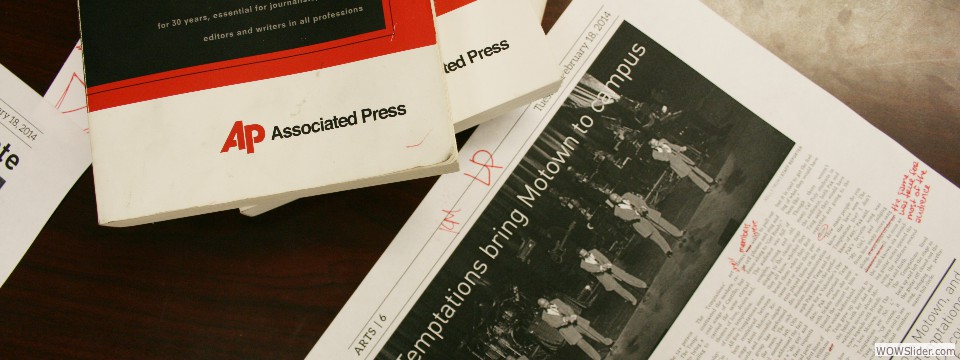 Work nights for the print edition of Mustang News are on Sunday and Wednesday nights from approximately 5 p.m. to 10 p.m. On Sundays, editors are in the newsroom starting at 3:30 p.m. for meetings. During the week, they often begin the day's work in the morning.
On work nights, copy editors edit stories on Wordpress while section editors lay out the pages for the print edition of the newspaper. Work nights for the print edition of Mustang News are on Sunday and Wednesday nights from approximately 5 p.m. to 10 p.m. On Sundays, editors are in the newsroom starting at 3:30 p.m. for meetings. During the week, they often begin the day's work in the morning.
On work nights, copy editors edit stories on Wordpress while section editors lay out the pages for the print edition of the newspaper.
 Section editors start with a blank slate when they arrive to work at 5 p.m. They fill their pages with content including stories and photographs.
Deputy news editor for digital and print and journalism sophomore Jacob Lauing said the job can be exhilarating.
"It's fun to have a blank slate because the possibilities are endless," Lauing said. "But oftentimes, it can be stressful when you don't know what stories you're going to run." Section editors start with a blank slate when they arrive to work at 5 p.m. They fill their pages with content including stories and photographs.
Deputy news editor for digital and print and journalism sophomore Jacob Lauing said the job can be exhilarating.
"It's fun to have a blank slate because the possibilities are endless," Lauing said. "But oftentimes, it can be stressful when you don't know what stories you're going to run." Once section editors print their pages (and each story has three edits on Wordpress), copy editors edit them for spelling, grammar and Associated Press Style. Suggestions for design improvements are also made.
Section editors then make these changes on their InDesign pages and copy editors make the changes on Wordpress.
On work nights, copy editors edit stories on Wordpress while section editors lay out the pages for the print edition of the newspaper.
"It can be tiring when you've been reading for a long time," copy editor and journalism senior Laura Pezzini said. "You have to be able to focus really hard to catch mistakes." Once section editors print their pages (and each story has three edits on Wordpress), copy editors edit them for spelling, grammar and Associated Press Style. Suggestions for design improvements are also made.
Section editors then make these changes on their InDesign pages and copy editors make the changes on Wordpress.
On work nights, copy editors edit stories on Wordpress while section editors lay out the pages for the print edition of the newspaper.
"It can be tiring when you've been reading for a long time," copy editor and journalism senior Laura Pezzini said. "You have to be able to focus really hard to catch mistakes." Editors tend to eat all three meals of their day in the newsroom.
Because of this, the newsroom fridge is often stocked with work night dinners which often means frozen lasagna for sports editor and graduate student Stephan Teodosescu.
The fridge is not only home to the day's meals, but also some expired meals as well. Bon appétit. Editors tend to eat all three meals of their day in the newsroom.
Because of this, the newsroom fridge is often stocked with work night dinners which often means frozen lasagna for sports editor and graduate student Stephan Teodosescu.
The fridge is not only home to the day's meals, but also some expired meals as well. Bon appétit. Once section editors make the changes on their InDesign pages, editor-in-chief and business administration senior J.J. Jenkins double checks the edits and sends them off to University Graphic Systems (UGS).
From there, UGS prints the paper the community sees on newsstands.
"It's terrifying," Jenkins said. "At some point, you just have to cross your fingers that you caught everything and there are no errors at all. You have to really trust your reporters and your editors that they got everything up to standard." Once section editors make the changes on their InDesign pages, editor-in-chief and business administration senior J.J. Jenkins double checks the edits and sends them off to University Graphic Systems (UGS).
From there, UGS prints the paper the community sees on newsstands.
"It's terrifying," Jenkins said. "At some point, you just have to cross your fingers that you caught everything and there are no errors at all. You have to really trust your reporters and your editors that they got everything up to standard."
 |



